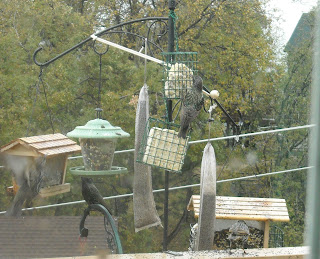In my last post, I mentioned seeing a mysterious new species of bird at my feeders. On further research, I discovered that they are European (English) Starlings. And wouldn't you know, they are here because of the famous Englishman William Shakespeare and an infamous American Eugene Schieffelin, a gentleman who, in the name of art, tampered with nature and caused a major disaster.
Apparently as president of the American Acclimatization Society, Schieffelin came up with the brilliant idea of introducing to America every bird species mentioned in the works of the great bard. In 1890, he released about 60 starlings to Central Park--and there are now somewhere between 140-200 million!
According to an article on "invasive species" (which says it all), "Starlings are among the worst nuisance species in North America. The birds travel in enormous flocks; pose danger to air travel; disrupt farms; displace native birds; and roost on city blocks. Corrosive droppings on structures cause hundreds of millions of dollars of yearly damage. In 2008 the U.S. government poisoned, shot or trapped 1.7 million, the most of any nuisance species."
Welcome to America!
Actually, if you think about it, they do exemplfy the American Dream. Wrenched from their homeland and plucked down in the heart of New York, they have managed to survive and thrive from sea to shining sea. They are driven and determined little creatures, letting nothing, not even the U.S. government, get in their way.
So it is no surprise that even on the foggiest, windiest day up here in the San Bernardino Mountains, in the pouring rain, with temperatures close to freezing and soon to bring snow, these hardy birds were the only ones at my feeders a few weeks ago, polishing off what seed was left.
I do admire their pluck and tenacity though their fierce spirit can be intimidating. I can't help but wonder if their ancesters in Europe were quite as intense or if this is a result of assimilation in America.
Perhaps it's time for a name change? This new species of European Starlings might be more appropriately known as American Starlings. What do you think?
For more information:
http://natureali.org/european_starling.htm
http://icwdm.org/handbook/birds/EuropeanStarlings.asp
http://en.wikipedia.org/wiki/Common_Starling

































